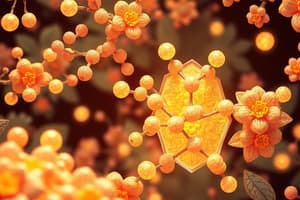Podcast
Questions and Answers
What characterizes a cis-isomer in fatty acids?
What characterizes a cis-isomer in fatty acids?
- It is always solid at room temperature.
- It has a double bond without any bends.
- It is bent or 'kinked,' preventing tight packing. (correct)
- It is linear and allows tight packing.
What is a key characteristic of trans-fatty acids?
What is a key characteristic of trans-fatty acids?
- They are liquid at room temperature.
- They contain multiple kinks in their structure.
- They are created during commercial food production. (correct)
- They are primarily made in the liver.
Which statement about triglycerides is correct?
Which statement about triglycerides is correct?
- They are synthesized from fatty acids alone.
- They are primarily found in the cell membrane.
- They are immediately usable for energy without modification.
- They serve as a major stored form of fat. (correct)
What happens during lipolysis?
What happens during lipolysis?
Which part of a phospholipid is hydrophilic?
Which part of a phospholipid is hydrophilic?
What is the primary role of cholesterol in biological membranes?
What is the primary role of cholesterol in biological membranes?
Which process converts excess carbohydrates into fat?
Which process converts excess carbohydrates into fat?
Which statement about fatty acid oxidation is true?
Which statement about fatty acid oxidation is true?
What process is involved in creating polymers from monomers?
What process is involved in creating polymers from monomers?
Which of the following is a common monosaccharide?
Which of the following is a common monosaccharide?
What type of bond forms between two monosaccharides to create a disaccharide?
What type of bond forms between two monosaccharides to create a disaccharide?
How are polysaccharides primarily distinguished?
How are polysaccharides primarily distinguished?
What is the molecular formula pattern for monosaccharides?
What is the molecular formula pattern for monosaccharides?
Which of the following statements about polymers is false?
Which of the following statements about polymers is false?
Which of the following is NOT a role of polysaccharides?
Which of the following is NOT a role of polysaccharides?
What is the primary component of starch?
What is the primary component of starch?
What structural changes occur in sickle-cell hemoglobin compared to normal hemoglobin?
What structural changes occur in sickle-cell hemoglobin compared to normal hemoglobin?
What happens to the quaternary structure of hemoglobin in sickle-cell compared to normal hemoglobin?
What happens to the quaternary structure of hemoglobin in sickle-cell compared to normal hemoglobin?
Which region of the sickle-cell hemoglobin is affected by the hydrophobic interactions?
Which region of the sickle-cell hemoglobin is affected by the hydrophobic interactions?
What is the primary function of normal hemoglobin?
What is the primary function of normal hemoglobin?
How does the primary structure of sickle-cell hemoglobin differ from normal hemoglobin?
How does the primary structure of sickle-cell hemoglobin differ from normal hemoglobin?
What effect does the interaction of sickle-cell hemoglobin have on oxygen transport?
What effect does the interaction of sickle-cell hemoglobin have on oxygen transport?
What type of secondary structure is most associated with normal hemoglobin?
What type of secondary structure is most associated with normal hemoglobin?
What is a similarity between the primary structure of normal and sickle-cell hemoglobin?
What is a similarity between the primary structure of normal and sickle-cell hemoglobin?
What type of bonds connect Adenine and Thymine in DNA?
What type of bonds connect Adenine and Thymine in DNA?
What is the primary function of DNA?
What is the primary function of DNA?
Where does the synthesis of mRNA take place?
Where does the synthesis of mRNA take place?
How many hydrogen bonds connect Cytosine and Guanine in DNA?
How many hydrogen bonds connect Cytosine and Guanine in DNA?
What role does mRNA play in protein synthesis?
What role does mRNA play in protein synthesis?
What defines the primary structure of a protein?
What defines the primary structure of a protein?
Which of the following describes a secondary structure of proteins?
Which of the following describes a secondary structure of proteins?
How are amino acids linked in proteins?
How are amino acids linked in proteins?
Which statement is true about R groups in amino acids?
Which statement is true about R groups in amino acids?
What characterizes the tertiary structure of a protein?
What characterizes the tertiary structure of a protein?
Which amino acids are considered polar?
Which amino acids are considered polar?
What is the significance of polypeptides being polymers of amino acids?
What is the significance of polypeptides being polymers of amino acids?
Which amino acid is an example of an electrically charged basic amino acid?
Which amino acid is an example of an electrically charged basic amino acid?
Flashcards are hidden until you start studying
Study Notes
Macromolecules: Polymers and Monomers
- Polymers are large molecules composed of repeating smaller units called monomers.
- Carbohydrates, proteins, and nucleic acids are polymeric.
Dehydration Synthesis and Hydrolysis
- Dehydration synthesis joins monomers to form polymers by removing a water molecule.
- Hydrolysis breaks down polymers into monomers by adding a water molecule.
Carbohydrates: Sugars
- Monosaccharides are simple sugars, often multiples of CH₂O (1:2:1 ratio).
- Glucose (C₆H₁₂O₆) is a common monosaccharide; others include fructose and galactose.
- Monosaccharides are categorized by carbonyl group location (aldose or ketose) and carbon skeleton length (trioses, pentoses, hexoses). Examples include glyceraldehyde, ribose, glucose, galactose, dihydroxyacetone, and fructose.
- Disaccharides form via dehydration reactions joining two monosaccharides with a glycosidic linkage (e.g., sucrose, lactose, maltose).
- Polysaccharides are complex carbohydrates with storage or structural roles; their structure depends on monomer type and glycosidic linkage positions. Starch is a plant storage polysaccharide composed entirely of glucose.
Lipids: Fats, Phospholipids, and Steroids
- Lipids are diverse hydrophobic molecules.
- Triglycerides are the main stored fat form; they are created via lipogenesis and broken down via lipolysis for energy.
- Phospholipids have hydrophilic heads and hydrophobic tails, making them amphipathic.
- Steroids include cholesterol (important for membrane fluidity) and sex hormones (e.g., estrogen, progesterone, testosterone). Cholesterol is carried by lipoproteins (VLDL, LDL, HDL).
Proteins
- Proteins are polymers of amino acids linked by peptide bonds. Amino acids have carboxyl and amino groups; their properties vary due to different R groups.
- Polypeptides have unique amino acid sequences.
- Protein structure has four levels:
- Primary: Unique amino acid sequence.
- Secondary: α-helices and β-pleated sheets formed by hydrogen bonds between backbone components.
- Tertiary: 3D structure determined by interactions between R groups.
- Quaternary: Arrangement of multiple polypeptide chains. Variations in these structures lead to different functions, as seen in normal versus sickle-cell hemoglobin.
Nucleic Acids: DNA and RNA
- Nucleic acids (DNA and RNA) are polymers of nucleotides.
- DNA replicates itself and directs mRNA synthesis, controlling protein synthesis via mRNA.
- In DNA, adenine pairs with thymine (2 hydrogen bonds), and cytosine pairs with guanine (3 hydrogen bonds). Protein synthesis occurs in ribosomes.
Studying That Suits You
Use AI to generate personalized quizzes and flashcards to suit your learning preferences.





